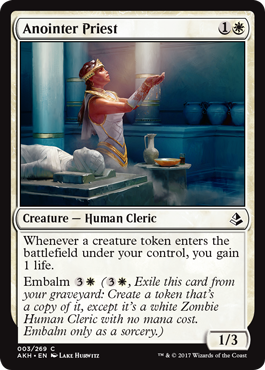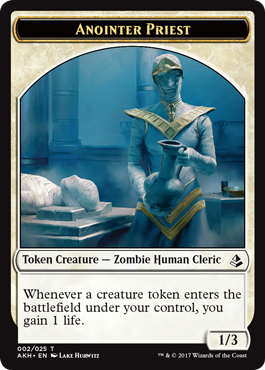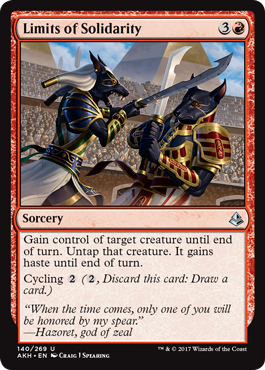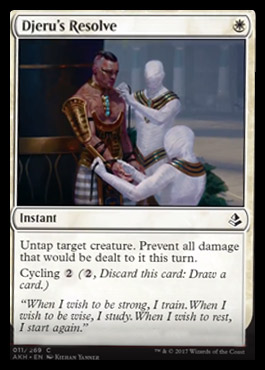Amonkhet previews have begun! One of the first articles we get from Wizards of the Coast during each spoiler season is the primer on set mechanics. Matt Tabak writes about the Amonkhet mechanics here. What can we predict about Amonkhet Limited based on this information?
Tabak highlights six mechanics: embalm, exert, aftermath, cycling, -1/-1 counters, and cartouches/trials. Read Tabak’s article to get the basic of each. Amonkhet has a lot of mechanics, and more complex interactions will emerge as more cards are spoiled. This week is part one, and I break down the big ones: embalm, exert, and cycling. How will each influence the Limited environment, both for draft and sealed? Let’s find out!
Embalm
Embalm is a new graveyard mechanic that riffs on flashback and unearth, as well as other creature recursion mechanics like persist and undying, and generic death triggers. Here’s a simple example on a common:
The embalm mechanic provides a new way to bring back a creature from the graveyard. The flavor captures mummification pretty well. Instead of getting the creature card back into play, you get a token that is mostly the same: they are white zombies (mummies) without the embalm mechanic and no converted mana cost, and tokens instead of cards, but otherwise the creature is the same. Here’s what [casthaven]Anointer Priest[/casthaven]’s token looks like:
Presumably they’ll spoil some non-white creatures with embalm, which will highlight the change of color inherent in the mechanic. The color identity probably doesn’t matter much for Limited gameplay—they don’t print protection or color-hosing cards too often these days. But embalm tells us a lot about how Limited will play out.
First, the fact they’re making unique tokens for each embalm creature gives us a lot of information. It likely means we won’t have other token creatures in the set. The collector number on this token shows there are twenty-five tokens in Amonkhet. A few may be planeswalker emblems, and maybe one or two non-mummy tokens will exist. But I’d bet we’re getting in the neighborhood of twenty embalm creatures in the set. That’s a lot.
How does embalm play out? Creature recursion tends to make blocking better than attacking. The exception arises when trading off with the recursive creature makes your situation even worse. That was true for undying—you probably don’t want [casthaven]Geralf’s Messenger[/casthaven] coming back if you can help it, so you didn’t block. This also applies to some death triggers that provide value, and mechanics like revolt or morbid. But I don’t think embalm fits that exception.
Embalm provides a second copy of a creature once the first dies (or gets discarded, milled, etc), but the mana cost looks similar to flashback. That means the token is less efficient than the original creature, assuming R&D learned their lesson from [casthaven]Lingering Souls[/casthaven]. An overpriced two drop is not what you want to cast on turn three. Embalm creatures are a resource you store up early, then cash in later when you run out of cards or flood out on mana.
For draft, that means defensive decks can dedicate more resources to surviving early without fear of running out of plays later. I suspect embalm will be a draft archetype while also providing some value to other decks on incidental creatures. Embalm will have a larger impact on sealed, because everyone who has them in their pool can play them, assuming they have the right colors of mana. Sealed is the slowest format, and generally favors attrition strategies. Embalm is perfect. I expect whichever colors have embalm (white, probably black, perhaps others) will be cominant colors. Bring some extra plains to your PPTQ.
Exert
Exert is an intuitive attacking mechanic. You can lock down your attacker for an extra turn (it won’t untap) to get extra value. This mechanic shows up in all sorts of games—borrow from your future to improve your present. Here’s a simple common to demonstrate:
Are you winning this turn? [casthaven]Ahn-Crop Crasher[/casthaven] can help, and the choice to exert is easy in such situations. But what if you aren’t? Can you afford to give away an attack or block next turn? It depends how much advantage you gain from exerting now. The permanent board presence is a big reason why creatures are essential to Limited. You want resources that stick around.
What if you ignore the exert ability? A 3/2 haste for 2R is right in red’s wheelhouse for Limited decks. Exert is a bonus, though like any extra choice, it comes with hidden drawbacks by giving you opportunities to make poor decisions. Exert also has a weird hidden/revealed information tension. In many games, you’ll want to hold haste creatures until you can attack and win on the spot. That plays well with exert, as it removes the drawback. But what if you want a 3/2 haste without needing to clear a blocker? If you play it, the exert ability sits on the board, telling your opponent not to rely on a single blocker to protect them. Does your opponent have to hold back an army? Do they make an unfavorable trade to get an exert creature off the board? A 3/2 haste is not very good after it has already attacked once. You might be happy to see your opponent spend a removal spell on it later.
Exert should be an excellent aggressive mechanic in draft. It pushes damage through while also leaving you vulnerable to counter-attacks. Both make games end faster, but only in aggressive archetypes. In sealed, however, I expect exert to play differently. Curving out and winning on turn five with no cards in hand is an inferior strategy. So does exert become a value mechanic? Get a hit in now, bait your opponent into trading unfavorably or wasting removal, while gaining incremental advantages. Long games provide more opportunities to make mistakes. I expect exert to be the most complicated mechanic in the set for competitive strategy.
Cycling
Yes! Cycling is a smoothing mechanic, like scry, while also a modular one, like charms. It’s one of the best ways to help all colors gain consistency over a long game. Paying two generic mana to trade a situational card for a new one is extremely powerful. Cycling will shape how both draft and sealed play out. Here’s a common example:
[casthaven]Threaten[/casthaven] effects are good except when they aren’t. Cycling a useless copy away is a great hedge. Big deal number one: Limited decks will have more situational effects because cycling reduces the cost putting them in your deck.
Cycling is also slow. A two mana rummage isn’t going to win the game quickly. Yes, there are some cards that trigger additional effects off cycling, but those also have to be in play already. Big deal number two: cycling is like morph—it’s colorless and converts early mana into later advantage. It’s also an instant-speed ability that can’t be countered, which favors sitting back on defense. In return, it helps decks find what they need to close the door or mount a comeback. Cheap instants also become better because holding up two mana could mean you want to cycle, masking other effects in your hand. [casthaven]Impeccable Timing[/casthaven] is happy to hear this news.
There may be a cycling achetype in draft, but this is mostly a value mechanic that all decks can use. In sealed, expect a lot of splashing for powerful and situational cycling cards. I love cycling so I’m very stoked to see it here.
Well that’s it for part one. Come back next week as I examine aftermath, -1/-1 counters, and cartouches/trials. And I’ll dig into how these mechanics overlap. Like, say, a card that untaps exerted creatures but also cycles!
Carrie O’Hara is Editor-in-Chief of Hipsters of the Coast.






